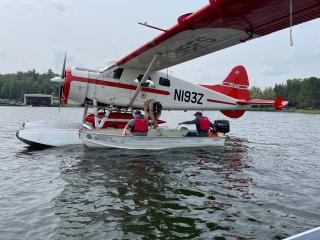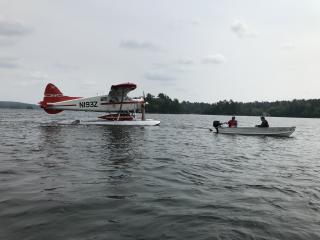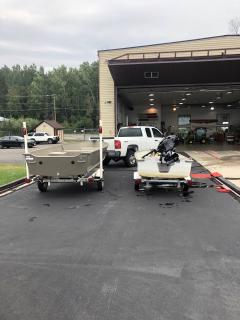Seaplane safety exercises provide invaluable improvements
MINNESOTA – For months, USDA Forest Service firefighters have been on the Superior National Forest and Canadian border battling blazes on the ground and from the sky. The Eastern Region’s seaplane program has been indispensable in the process, shuttling fire crews, gear, food and canoes; conducting reconnaissance flights providing an airborne perspective to help firefighters formulate plans; and scooping and dropping water on smaller fires or where structures are threatened.

Guided by our core values of safety and interdependence, the seaplane crew work year-round to make sure they are ready to respond to any situation.
“We operate in a dangerous environment. We owe it to our pilots and crew to be the best prepared we can be,” said Bill Kehoe, regional aviation safety manager.
This year, for its annual aviation mishap drill, as required by the National Wildfire Coordinating Group Aviation Mishap Response Guide and Checklist, seaplane program leaders executed two scenarios focusing on live aircraft recovery and a pilot water rescue exercise.
- Scenario 1 – Aircraft Recovery
-
The aircraft recovery exercise called for a floatplane to experience engine malfunction and pilot Joel “Henny” Jungemann must abort take-off. A rescue boat is dispatched to recover the aircraft and tow it back to the dock. Two different towing techniques were used to see which method was most efficient. One method utilized a bridle attachment off the front of the floats and a tow rope, while side towing was used as the second. The side towing technique proved to be more effective to control both the boat and seaplane.
- Scenario 2 – Pilot Water Rescue
-
The afternoon drill simulated a crash in which the pilot needed to be rescued from the water. For safety reasons, an emergency inflatable rescue raft was used. The pilot practiced deploying the raft and inflating her personal flotation device while the crew in the rescue boat practiced using a throw line and rescue ladder to assist getting the pilot aboard the rescue boat.
An after-action review identified areas of success and opportunity, including several needs to better conduct rescue operations of pilots and tow aircraft back to base. The most significant item identified was the need for a larger rescue boat to tow aircraft. The base replaced the older, narrower 14-foot boat and transferred the existing outboard to a new 16-foot Alumacraft, V-16 that was in inventory at a local boat dealer in Grand Rapids, Minnesota.
The Eastern Region’s seaplane program dates back to 1929 when local seaplane pilots began flying fire detection flights and hauling fire crews for the Forest Service. In 1935, the first contract was issued for seaplane usage. The Forest Service acquired its first dedicated aircraft in 1938, and the seaplane program has been flying high ever since. Today, the program is a fleet of three de Havilland Beavers located at the Forest Service Seaplane Base in Ely, Minnesota.


